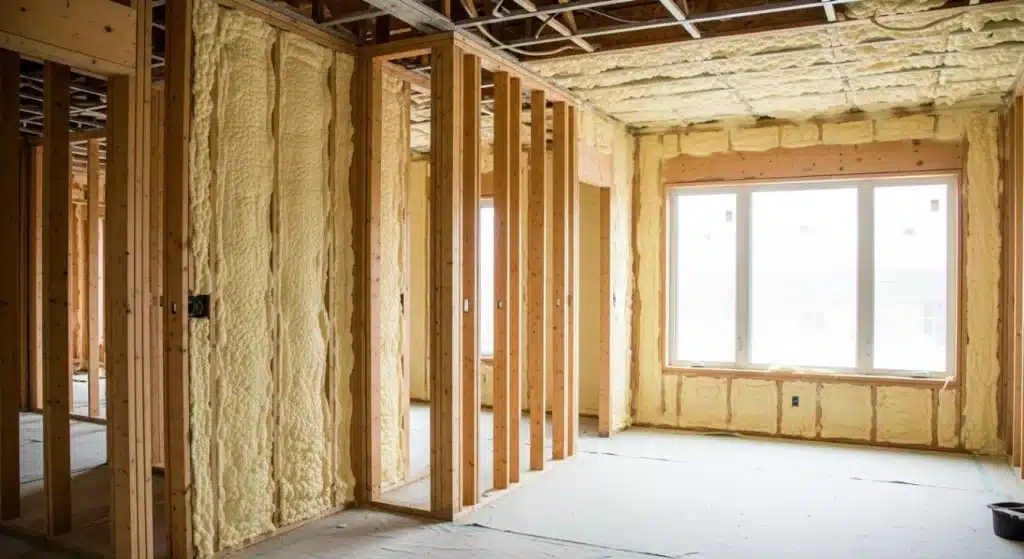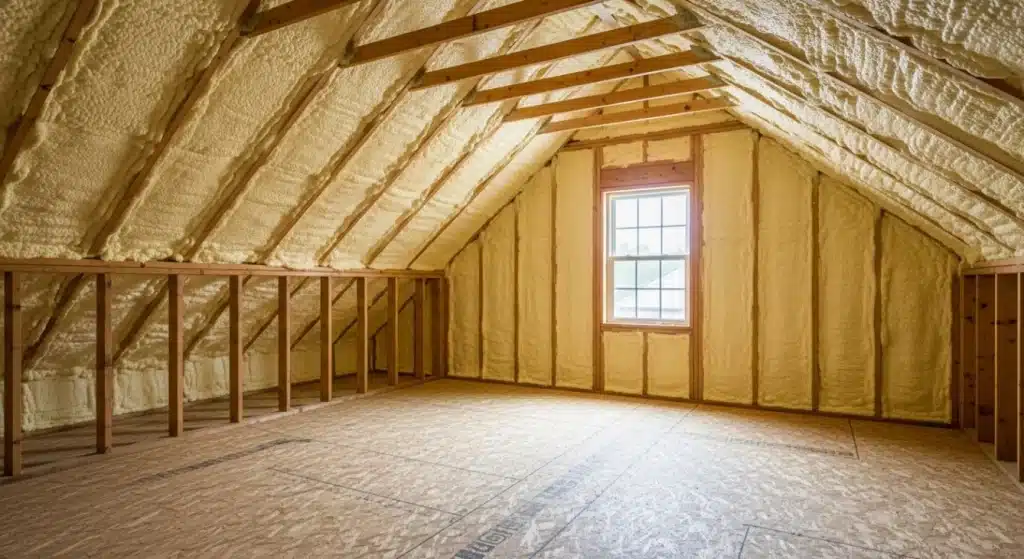Spray foam insulation starts as a liquid mixture that turns into a solid foam through a chemical reaction. This reaction causes the material to expand up to 100 times its original volume, filling cracks, crevices, and voids in walls, attics, and floors. In Madera homes, where temperatures swing from scorching summers over 100 degrees to chilly winters, this expansion creates a tight seal that blocks air leaks and moisture, improving energy efficiency right away.
This article breaks down the process behind that expansion, from the basic chemistry to real-world effects in the local climate. Readers will learn how it works and why it matters for structures built to handle Central Valley heat. Information here draws from hands-on work installing spray foam in Madera County for over a decade, giving a clear view of what happens during and after application.
How Spray Foam Forms and Reacts
The core of spray foam lies in two main parts: an isocyanate and a polyol resin. Technicians mix these on-site using a spray gun. Once combined, they react with each other and the air’s moisture to produce polyurethane foam. This reaction releases carbon dioxide gas, which forms bubbles inside the mixture. Those bubbles make the foam grow rapidly, often within seconds of spraying.
In practice, the expansion happens in stages. First, the liquid hits the surface and sticks. Then, it begins to rise as gases build up. Full expansion takes about 30 to 60 seconds, depending on temperature and humidity. For Madera homes, where summer heat can speed up the reaction, installers adjust the mix to avoid over-expansion that might warp framing.
Step-by-Step Expansion Mechanics
Start with preparation. Surfaces get cleaned of dust and debris to ensure good adhesion. The spray gun then delivers the mixture at high pressure, about 1,000 to 1,200 psi. As it leaves the nozzle, the components blend and the reaction kicks in.
The foam adheres to most building materials like wood, metal, or concrete. It expands to fill odd shapes, such as around pipes or electrical boxes, where traditional batts or fiberglass fall short. In closed-cell foam, a denser type, the expansion creates a rigid structure that also acts as a vapor barrier. Open-cell, lighter versions absorb sound better but expand less aggressively.
Here’s a quick comparison of the two main types:
| Type | Density (lbs/ft³) | Expansion Rate | Best For in Madera Homes |
|---|---|---|---|
| Open-Cell | 0.5 – 0.8 | Up to 100x | Soundproofing in interior walls |
| Closed-Cell | 2.0 – 3.0 | Up to 30x | Moisture control in attics |
This table shows why closed-cell suits Madera’s dry climate, where it prevents heat gain without trapping humidity.
Bonus Tip: Test a small area first in hot weather to gauge expansion speed and avoid uneven coverage.
Chemical Reaction Details
As described earlier, the isocyanate reacts with water in the air or added to the polyol, forming polyurea and releasing CO2. That gas expands the foam. Catalysts in the mix control how fast this occurs, typically aiming for a rise time under a minute. Heat from the reaction can reach 200 degrees Fahrenheit, so installers wear protective gear.
Data from the U.S. Department of Energy indicates that spray foam reduces air infiltration by up to 80% compared to other insulations. In Madera, where air conditioning runs hard in July and August, this cut in leaks means lower bills. A 2022 report from the Spray Polyurethane Foam Alliance notes that properly installed foam lasts 25 to 80 years without settling.
Transitioning to local needs, Madera’s clay soils and occasional fog mean moisture management matters. Expansion seals out damp air, reducing mold risk in crawl spaces. Understanding this reaction highlights why spray foam’s expansion is particularly advantageous in Madera’s variable climate, offering targeted benefits against heat and moisture.

Benefits Specific to Madera’s Climate
Madera sits in the San Joaquin Valley, facing extreme heat and occasional winter rains. Spray foam’s expansion fills gaps that let hot air seep in, keeping interiors cooler. It also provides an R-value of 6 to 7 per inch, higher than fiberglass’s 3 to 4.
Market facts back this up. The California Energy Commission reports that homes with advanced insulation like spray foam save 20-30% on cooling costs in hot regions. For Madera residents, that translates to hundreds of dollars yearly during peak summer.
Expansion also seals against pests common in rural areas, like termites entering through tiny wall cracks. In attics, it prevents radiant heat from baking the house.
Bonus Tip: Combine spray foam with ridge vents in attics to let hot air escape while the foam blocks conduction heat.
Things to Consider Before Making a Decision
While the benefits are clear, homeowners should evaluate several factors before proceeding with spray foam installation. Assess your home’s age and structure. Older Madera homes with settling foundations might need extra support before insulation to avoid trapping issues. Check local building codes through the Madera County Building Department; they require permits for foam installs over certain thicknesses.
Cost runs $1 to $3 per square foot, depending on type and access. Weigh energy savings against upfront price. Health factors include off-gassing during install, so ensure ventilation and hire licensed pros. Finally, evaluate if your home’s layout suits full coverage or targeted areas like rims and headers.
Common Questions
How long does spray foam take to cure?
Spray foam begins setting within minutes but requires about 24 hours to fully cure. This ensures maximum durability and insulation performance.
Can homeowners apply spray foam themselves?
DIY kits are available, but they rarely match professional results. Trained installers use specialized equipment to guarantee even coverage and eliminate voids that weaken efficiency.
Bonus Tip: Schedule installs in milder weather, like spring or fall in Madera, for predictable results and less worker strain.
Key Takeaways on Spray Foam Expansion
The process turns liquid into an expanding foam via chemical reaction, sealing Madera homes against local weather extremes. It delivers lasting air barriers and efficiency gains. Homeowners should review their setup, climate needs, and budget to see if it fits long-term plans.
Next Steps for Better Home Insulation
Evaluate current drafts in your Madera home with a simple blower door test. Contact Supreme Spray Foam – Fresno at (559) 545-0800 or [email protected] for a no-obligation assessment. Professionals can measure gaps and explain expansion suited to your build, helping decide on the right approach without pressure. This step clarifies options and avoids common pitfalls in local installs.
Sources
- U.S. Department of Energy – Government site detailing insulation types and performance data, including air infiltration reductions.
- Spray Polyurethane Foam Alliance – Industry organization providing reports on foam durability and installation best practices.
- California Energy Commission – State agency resource on energy savings in California climates, with stats on cooling cost reductions.
Frequently Asked Questions About Spray Foam in Madera
Does spray foam work well in hot climates like Madera’s?
Yes, it excels here by creating an airtight barrier that resists the valley’s intense sun. The expansion fills seasonal gaps from wood movement, maintaining efficiency year-round.
How long does the expansion take during installation?
From spray to full rise, it completes in 20 to 80 seconds. Factors like ambient temperature influence this; hotter days speed it up.
Can spray foam cause issues with home resale in Madera?
Not usually, as it boosts energy ratings that appeal to buyers. Disclose installation details to meet county appraisal standards.
Is open-cell or closed-cell better for humid spots?
Closed-cell handles moisture better with its impermeable structure, ideal for Madera basements prone to groundwater.
What maintenance does spray foam need after expansion?
Minimal; inspect for physical damage every few years. It doesn’t sag or lose R-value over time in stable conditions.


